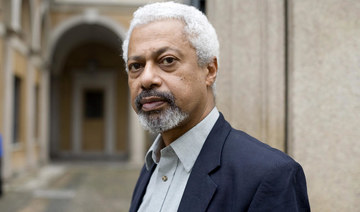NEW YORK: Megha Majumdar, whose novel “A Burning” was among the most talked about debuts of recent years, is among 10 recipients of a Whiting Award for emerging authors. Fiction writers Claire Boyles and Nana Nkweti, poets Ina Cariño and Anthony Cody and nonfiction writers Anaïs Duplan and Alexis Pauline Gumbs also will receive $50,000 each in prize money.
Others honored Wednesday at a Manhattan ceremony include fiction writer Rita Bullwinkel, poet Claire Schwartz and nonfiction writer Jesse McCarthy.
“As the world opens up, these brilliant writers open up our world,” said Courtney Hodell, director of Literary Programs for the Whiting Foundation. “From fresh cultural criticism, to poems of place and personhood and appetite, to fiction that brings surreal wit to compassionate portraits, their work is the spring thaw of the mind.”
The awards were established in 1985 and have previously gone to future literary stars such as Jonathan Franzen, Colson Whitehead and Tracy K. Smith.
Novelist Megha Majumdar among winners of Whiting Award
https://arab.news/64nax
Novelist Megha Majumdar among winners of Whiting Award

What We Are Reading Today: ‘Good Vibes, Good Life’

Author: Vex King
“Good Vibes, Good Life: How Self-Love is the Key to Unlocking Your Greatness” by Vex King is a self-help book on cultivating a positive mindset and emotional well-being. The author shares his own personal journey of overcoming adversity and tells how he developed practical strategies to improve his outlook on life.
It has an approachable and conversational tone. King writes in a personable manner, sharing his personal experiences and lessons acquired, making it relatable and relevant for readers.
The book covers a wide range of themes, including how to manage negative thoughts, practice appreciation, set boundaries, and discover your purpose.
King presents a variety of real exercises and tactics that readers may use right away to transform their mentality and improve their mental health.
The chapter on self-love is particularly impactful. King emphasizes the importance of being compassionate and accepting toward oneself, which he argues is the foundation for developing healthy relationships and achieving personal growth.
However, I felt that “Good Vibes, Good Life” sometimes tried to simplify complex emotional and mental health issues. While I appreciate the author’s goal of providing easy-to-understand self-help advice, there were times where the messaging felt too simplistic.
Another thing that gave me pause was that the author often did not use scientific research to support ideas. As someone who likes to see evidence-based information, I would have preferred if the author had included more references to psychological studies and expert opinions to back up his recommendations.
Instead, the book mostly relies on the author’s own personal stories and experiences. While those personal anecdotes can be compelling, I don’t think that automatically makes the strategies universally applicable to everyone.
Finally, I had mixed feelings about the work’s broad scope. On the one hand, I appreciated the wide range of topics covered; but on the other, I felt that certain areas could have benefited from a more in-depth, nuanced exploration, rather than a relatively surface-level treatment.
Overall, “Good Vibes, Good Life” is an uplifting and practical guide that can help readers develop a more positive and fulfilling outlook on life. The author’s personal anecdotes and straightforward advice make it an easy and engaging read.
It is a good option for those seeking to cultivate more joy, peace, and emotional well-being in their life.
What We Are Reading Today: ‘Strabo’s Geography’

Author: TRANSLATED WITH COMMENTARY BY SARAH POTHECARY
Strabo’s Geography is an encyclopedic description of the ancient world as it appeared to a contemporary observer in the early Roman empire.
Information about taming elephants, collecting saffron, producing asphalt, and practicing yoga is found alongside accounts of prostitution, volcanic activity, religious festivals, and obscure eastern dynasties—all set against the shifting backdrop of political power in the first century CE.
What We Are Reading Today: Artemisia Gentileschi and the Business of Art

Author: Christopher R. Marshall
Art has long been viewed as a calling—a quasi-religious vocation that drives artists to seek answers to humanity’s deepest questions. Yet the art world is a risky, competitive business that requires artists to make strategic decisions, especially if the artist is a woman. In “Artemisia Gentileschi and the Business of Art,” Christopher Marshall presents a new account of the life, work, and legacy of the Italian Baroque painter, revealing how she built a successful four-decade career in a male-dominated field—and how her business acumen has even influenced the resurrection of her reputation today, when she has been transformed from a footnote of art history to a globally famous artist and feminist icon.
Combining the most recent research with detailed analyses of newly attributed paintings, the book highlights the business considerations behind Gentileschi’s development of a trademark style as she marketed herself to the public across a range of Italian artistic centers. The disguised self-portraits in her early Florentine paintings are reevaluated as an effort to make a celebrity brand of her own image. And, challenging the common perception that Gentileschi’s only masterpieces are her early Caravaggesque paintings, the book emphasizes the importance of her neglected late Neapolitan works, which are reinterpreted as innovative responses to the conventional practices of Baroque workshops.
What We Are Reading Today: ‘Healing is the New High’

Author: Vex King
The self-help book, “Healing is the New High,” attempts to teach people how to embrace recovery from trauma and reclaim power in their lives.
Written by Vex King, a prominent figure in the health and personal growth community, it provides strategies for overcoming life’s problems and nurturing inner peace.
King’s central message is that healing can be a potent avenue for introspection and transformation. The book, published in 2021, is written simply and in a warm tone, as King seeks to relate to the struggles people experience on a daily basis.
Every chapter can be read as a standalone, so readers can start at any point in the book.
King writes candidly about facing emotional pain in his own life and how he overcame it.
There appears to be a fair amount of repetition, but it could be argued that King is attempting to reinforce key concepts.
And while the ideas he is promoting may not be entirely novel to seasoned self-help readers, the way he presents his own personal struggles makes this a special read.
It is a powerful and insightful book that offers a holistic approach to personal growth and transformation.
Book Review: ‘Vanderbilt’ by Anderson Cooper

Written during the pandemic in 2021, “Vanderbilt: The Rise and Fall of an American Dynasty” looks at the Vanderbilt family, one of the most famous in US history, written by one of its own.
It was penned by journalist Anderson Cooper, formerly of CNN, and while many of us rifled through old archives while on lockdown in our own homes, Cooper attempted to piece together fragments of his own history — and US history.
The book begins with young Cornelius “the Commodore” Vanderbilt at the beginning of the 19th century. Through grit, and a pathological desire to acquire money at all costs, he was able to build two giant empires, one in shipping and another in railroads, that would make him the richest man in America. His staggering fortune was fought over by his heirs until well after his death in 1877.
His great-great-great-grandson is Cooper and this personal yet exhaustive book covers a vast amount of real estate — both in stories and locations — as historian Katherine Howe, his co-writer, and Cooper explore the story of the legendary family and its influence.
Cooper and Howe breathe life into the former’s ancestors who built the family’s vast empire, basked in the Commodore’s wealth and became synonymous with American capitalism and high society.
Moving from old Manhattan to the lavish Fifth Avenue, from the ornate summer palaces to the courts of Europe and modern-day New York, Cooper and Howe recount the triumphs and tragedies of this American dynasty.
The vignettes are often fascinating and give context to tales often recounted, like that of Alva Belmont, who was married to a Vanderbilt before pivoting to a world of activism. In her heyday she hosted one of the most lavish gala balls of all time, held in 1883, which inspired many a TV series and fanciful gossip following her rivalry with the infamous Caroline Schermerhorn Astor.
The story looks at the melancholic life of Alva’s daughter, Consuelo, and at her eventual happy ending.
Cooper and Howe delve into corners of stories that are more or less unknown. I was particularly fascinated by the story of his relative who lived in a museum for years, before being eventually kicked out.
The stories link and go back and forth on the timeline, perhaps making it slightly confusing for the lay reader.
It does really require the reader to have some prior knowledge of the Vanderbilt family, with its many scandals and nuances.
The authors also go into detail about the lives, and deaths, of the many Vanderbilt men.
The last part of the book spends time exploring the late Gloria Vanderbilt, Cooper’s mother. These passages are the most emotional in the book.
Cooper, who is now a father, explains how writing the book helped to provide a historical context which his son can read about in later life to understand the story behind the stories, and tall tales, written about their family.



















